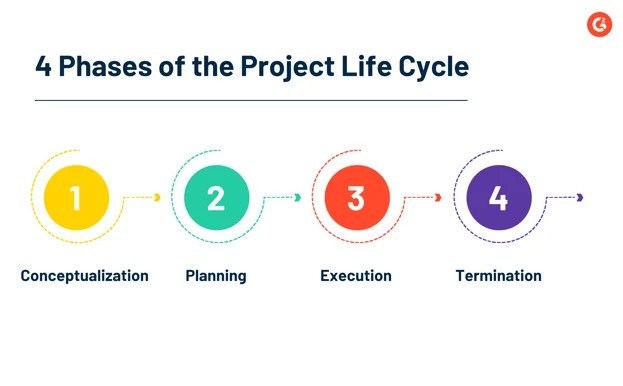
The Importance of a Project Management Timeline
Project management involves the strategic planning and execution of initiatives, such as websites, applications, or systems. It helps teams achieve objectives, allocate resources, deal with risks, and meet deadlines. In fact, dedicated development teams can use a project management timeline to facilitate effective and timely execution.
A skilled, dedicated project manager ensures the team delivers high-quality results on time and within budget. The project management lifecycle offers a structured framework for development teams. A well-structured project timeline can help:
- Manage client expectations;
- Facilitate easier project tracking, and
- Prioritize tasks to meet deadlines.
A Briefer on Project Management
Project management is the structured oversight of a business project to meet specific objectives and deliverables. It can be a one-time initiative or a recurring operational effort. It involves managing resources such as budgets, personnel, and technology.
Projects are best executed under the leadership of a dedicated manager. They leverage particular project management tools to streamline workflows and are responsible for:
- Aligning the project with business objectives;
- Defining and maintaining project scope to avoid deviation;
- Managing risks effectively;
- Overseeing budget allocation and usage;
- Ensuring alignment among team members and stakeholders, and
- Meeting deadlines.
The project management lifecycle offers a step-by-step framework for planning, executing, and closing projects. The stages typically include:
- Initiation
- Planning
- Execution
- Closure

Why a Project Timeline is Important
A project timeline visually represents tasks, milestones, and deadlines in chronological order. It helps the team understand the schedule, allocate resources efficiently, and track progress.
Managers can use a timeline to clearly communicate schedules to stakeholders. It also breaks down and defines key tasks and milestones into an understandable format for both clients and teams, reducing the need for separate documents.
Moreover, setting up a project timeline helps manage client expectations. They can track ongoing work and upcoming deliverables, allowing them to request updates and know what to expect at a given time.
Here are some of the reasons why the project timeline is so vital:
Easier Project Tracking
Project managers rely on timelines from project management tools to schedule and monitor deliverables effectively. It’s a visual representation of project schedule, helping managers map out tasks. This structure approach is the key factor in project success, and according to FinancesOnline, 77% of high-performing projects utilize project management software.
If progress stalls, managers can quickly spot delays and adjust accordingly. Timelines offer real-time control, allowing for immediate rescheduling when needed.
Prioritized Tasks Done First
Timelines are crucial for prioritizing tasks and ensuring deliverables meet quality standards. Even when issues arise, a timeline helps managers quickly re-prioritize.
Changing priority tasks may require reorganizing the original plan. A timeline makes it easier to shift non-critical tasks and prioritize urgent ones. For instance, ensuring on-time QA testing is more manageable with a well-maintained timeline.
Setting timelines for tasks and deliverables allows team members to prioritize work and meet deadlines. This leads to a final output that meets project standards and specifications.
Improved Team Communication
Strong team communication is a necessity. As a matter of fact, Project Management Statistics show that poor communication causes up to 30% of project failures. Timelines serve as a shared reference, aligning all parties involved.
A detailed timeline shows who is responsible for each task. Project managers can use it to convey milestones and deadlines to stakeholders and team members.
Each member can relay the right information, ask for clarifications, and address particular concerns to the appropriate person, enhancing collaboration and clarity.
Better Time and Resource Allocation
Exploding Topics revealed that 34% of organizations completed projects mostly or on time, underlining the need for better planning.
A detailed timeline helps plan sequential tasks to stay aligned with project goals and improve resource planning by identifying peak resource demand periods.
As such, team members stay focused and aware of their responsibilities and deadlines, preventing any delays or roadblocks in the project’s progress.
Enhanced Team Motivation
Motivated teams perform better, and clear timelines help maintain that drive. By setting visible goals and deadlines, a timeline builds accountability and momentum.
Checking off completed tasks reinforces progress, boosting morale and efficiency. This, in turn, leads to a more streamlined workflow and increases the chances of successful project outcomes.
Keep Projects On Time and Within Budget
Project management is critical for businesses, especially when guided by a skilled, dedicated manager using a proper timeline template and software.
Integrating a project timeline into your business operations helps ensure deliverables are completed on time and within budget.
A dedicated project manager brings focus and structure, optimizing team workflows and schedules. With the help of timelines and project management software, managers can proactively manage risks during the execution. They also excel in allocating resources efficiently and managing budgets wisely.
Additionally, they facilitate clear communication among dedicated team members and business stakeholders. With the right tools, your projects can stay on track, meet expectations, and deliver lasting results.
This article was updated on May 16, 2025.
FAQs About Project Management Timeline
What tools are used to manage the timeline?
Our expert team uses platforms like Asana, Jira, Trello, or your preferred project management software to create and manage detailed timelines tailored to your project.
Can timelines be adjusted mid-project?
Yes. Project timelines are living documents. You can adjust them as needed to accommodate new priorities or unforeseen challenges, all while keeping you informed.
How does a dedicated team use a project management timeline?
Our dedicated team utilizes project timelines to structure workflows, assign responsibilities, and monitor progress, ensuring efficiency and accountability from start to finish.



















Comment 0